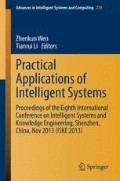Abstract
As the fast development of social network and electronic business, a huge number of comments are generated by users every day. Extraction of emotional elements is an important pre-task of sentiment analysis and opinion mining for comments. In this paper, we extract the emotional elements such as the opinion holder, the comment target, and the evaluation phrase, which previous researches rarely concerned about, especially in Chinese. Based on Conditional Random Fields, we label the evaluation phrase which structure is simple. Then on account of unique characteristics of grammar and syntax of Chinese, we design several rule-based methods to extract evaluation phrase which is in complex structure, as well as comment targets and opinion holders. According to the experimental results, our method improves the performance of emotional element extraction in the domain of sentiment analysis for automobile’s Chinese comments. And it also contributes greatly to our subsequent task such as sentiment analysis of social media or comments from other domains.
Access this chapter
Tax calculation will be finalised at checkout
Purchases are for personal use only
References
Kim SM, Hovy E (2005) Automatic detection of opinion bearing words and sentences[A]. In: Carbonell JG, Siekmann J (eds) Proceedings of the IJCNLP 2005. Springer, New York, pp 61–66
Popescu AM, Etzioni O (2005) Extracting product features and opinions from reviews[A]. In: Mooney RJ (ed) Proceedings of the HLT/EMNLP 2005. Association for Computational Linguistics, Morristown, pp 339–346
Pang B, Lee L, Vaithyanathan S (2002) Sentiment classification using machine learning techniques. In: Isabelle P (ed) Proceedings of the EMNLP 2002. Now Publishers Inc., Hanover, pp 79–86
Bloom K, Garg N, Argamon S (2007) Extracting appraisal expressions. In: Sidner C (ed) Proceedings of the HLT-NAACL 2007. Association for Computational Linguistics, Morristown, pp 308–315
Whitelaw C, Garg N, Argamon S (2005) Using appraisal groups for sentiment analysis. In: Fuhr N (ed) Proceedings of the CIKM 2005. ACM, New York, pp 625–631
Wilson T, Wiebe J, Hoffmann P (2005) Recognizing contextual polarity in phrase-level sentiment analysis[A]. In: Brew C, Chien LF, Kirchhoff K (eds) Proceedings of the HLT/EMNLP 2005. Association for Computational Linguistics, Morristown, pp 347–354
Bloom K, Argamon S (2009) Automated learning of appraisal extraction patterns. Lang Comput 71(1):249–260
Choi Y, Cardie C, Riloff E (2005) Identifying sources of opinions with conditional random fields and extraction patterns. In: Mooney RJ (ed) Proceedings of the HLT/EMNLP 2005. ACL, Morristown, pp 355–362
Riloff E, Wiebe J (2003) Learning extraction patterns for subjective expressions. In: Collins M, Steedman M (eds) Proceedings of the EMNLP 2003. ACL, Morristown, pp 105–112
Moilanen K, Pulman S (2007) Sentiment composition. In: Mitkov R (ed) Proceedings of the recent advances in natural language processing international conference, pp 378–382
Choi Y, Cardie C (2008) Learning with compositional semantics as structural inference for sub-sentential sentiment analysis. In: Lapata M, Ng HT (eds) Proceedings of the empirical methods in natural language processing. ACL, Morristown, pp 793–801
Kim SM, Hovy E (2006) Extracting opinions, opinion holders, and topics expressed in online news media text. In: Dale R, Paris C (ed) Proceedings of the ACL workshop on sentiment and subjectivity in text. pp 1–8
Lafferty J, McCallum A, Pereira F (2001) Conditional random fields: probabilistic models for segmenting and labeling sequence data. In: 18th International Conference on Machine Learning 2001. ACM Press, Williamstown, MA, USA, pp. 282–289
Yao T, Nie Q, Li J (2006) An opinion mining system for chinese auto-mobile reviews. In: Proceedings of the 25th anniversary of the Chinese information processing society of China, Beijing
Author information
Authors and Affiliations
Corresponding author
Editor information
Editors and Affiliations
Rights and permissions
Copyright information
© 2014 Springer-Verlag Berlin Heidelberg
About this paper
Cite this paper
Wang, Y., Liu, Q., Huang, H. (2014). Emotional Element Extraction Based on CRFs. In: Wen, Z., Li, T. (eds) Practical Applications of Intelligent Systems. Advances in Intelligent Systems and Computing, vol 279. Springer, Berlin, Heidelberg. https://doi.org/10.1007/978-3-642-54927-4_48
Download citation
DOI: https://doi.org/10.1007/978-3-642-54927-4_48
Published:
Publisher Name: Springer, Berlin, Heidelberg
Print ISBN: 978-3-642-54926-7
Online ISBN: 978-3-642-54927-4
eBook Packages: EngineeringEngineering (R0)

